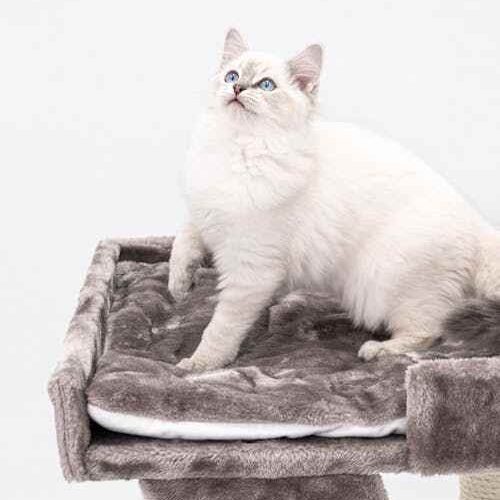Ragdoll cats are a beloved breed known for their large size, affectionate nature, and stunning appearance.
Ragdoll cats go through rapid growth stages, doubling their weight in the first week and hitting 1.7 lbs at two months old. Ensuring proper nutrition is essential during this fast development. By six months, most reach 2 to 4 kilograms. It takes around three years for them to reach full maturity, with males weighing 12 to 21 pounds and females 8 to 15 pounds.
The first few years are important for watching a Ragdoll evolve. Understanding these stages helps provide the best care for your feline friend‘s growth and development.
Rapid Growth in First Months
During the initial months of their lives, Ragdoll kittens experience rapid growth in both size and development. Within the first week, these kittens double their birth weight, reaching around 1.7 lbs by two months old and tripling their weight.
As they go through growth spurts, their increased food intake becomes vital, necessitating specialized kitten food until they’re one year old. This accelerated growth isn’t just about weight gain; it also reflects in their activity levels and coordination.
Ragdoll kittens start exhibiting more playfulness, curiosity, and motor skills development. By five weeks old, they begin practising behaviours like walking, pouncing, and wrestling, all essential for their shift to adult cat behaviours.
Weight Milestones in Ragdoll Kittens
Experiencing rapid growth, Ragdoll kittens achieve significant weight milestones in their early stages of life. Ragdoll kittens typically double their birth weight within the first week, showcasing their rapid development.
By the twelfth week, these kittens should weigh between 900g to 1.4kg, marking an important growth stage. At two months old, Ragdoll kittens may weigh around 1.7 lb, indicating healthy progress.
Most Ragdoll kittens reach a weight of 2 to 4 kilograms by six months, reflecting steady growth. Throughout the first year, these kittens undergo growth spurts, emphasizing the need for specialized kitten food until they’re one year old to support their continuous development.
Transition to Adult Size
As Ragdoll cats mature, they reach their full adult size around three years old, with males typically weighing between 12 to 21 pounds and females weighing between 8 to 15 pounds.
During the progression to adult size, significant changes occur in a Ragdoll cat’s weight. In the first 1.5 years of life, kittens experience rapid growth, doubling their body weight in just one month. By 6 months old, both male and female Ragdoll kittens should weigh more than 6.0 lbs, showcasing their quick development during this period.
At 3 months of age, Ragdoll kittens usually weigh around 3-4 lbs, which is at the upper end of the average kitten size range. This slow maturation process in Ragdoll cats involves continuous size and colour changes until they reach three years old.
Timeframe to Full Growth Of Ragdoll
To understand the timeframe for Ragdoll cats to reach full growth, it’s important to consider their maturation process and how it unfolds over the first few years of their lives.
Ragdolls undergo significant changes in the first 1.5 years, with kittens doubling their body weight in just a month during their rapid growth phase. By 6 months, both male and female Ragdoll kittens should weigh more than 6.0 lbs, with 3-4 lbs being the average at 3 months old.
It typically takes Ragdolls around 3 years to reach their full size and maturity. After the initial rapid phase, their growth rate slows down, but the first few years are essential for watching a Ragdoll grow.

Gender Differences in Size
Observing Ragdoll cats as they grow reveals noticeable size differences between males and females. Male Ragdolls weigh between 12 and 21 pounds, while females typically weigh 8 to 15 pounds. This weight gap is significant, with males often doubling the weight of females.
Male Ragdolls tend to have a more robust and muscular build, while females display a more petite and slender appearance. These gender disparities in size are common among Ragdoll cats and become more evident as they continue to grow.
When caring for these cats, it’s important to bear in mind the average weight differences between genders to make sure they receive the appropriate amount of healthy food for their size and breed.
Frequently Asked Questions
How Long Does It Take for a Ragdoll Cat to Grow to Full Size?
It takes Ragdoll cats around 4 years to reach full size and maturity. Significant growth occurs in the first 1.5 years, with kittens doubling their monthly weight. By 6 months, they should weigh over 6 pounds.
At What Age Is a Ragdoll Cat Fully Grown?
We become fully grown Ragdoll cats by around 3 to 4 years of age. Our journey involves growth milestones, nutritional needs, behavioral changes, health considerations, exercise requirements, grooming tips, socialization skills, playtime routines, weight management, and maturity indicators.
What Age Will My Ragdoll Get Fluffy?
We noticed our Ragdoll cat started getting fluffy around 6-8 weeks old. Their fur became more plush and dense as they grew, reaching peak fluffiness at 2-3 years. Regular grooming is key to maintaining their exquisite coat.
How Much Bigger Is a Ragdoll at 6 Months?
At 6 months, Ragdolls typically weigh between 2.5 to 2.7 kilograms. Feeding and playtime activities influence their growth. Monitoring weight milestones, implementing training techniques, and grooming needs are crucial. Socialization, exercise, health check-ups, behavior changes, and sleeping habits impact their development.
Conclusion
Overall, understanding the growth stages of ragdoll cats is important for their health and development.
For example, my ragdoll kitten, Luna, quickly doubled in size in her first few months, reaching key weight milestones along the way.
As she progressed to adulthood, her growth slowed down, but she continued to fill out and reach her full size by about two years old.
Each cat is unique, but knowing what to expect can help guarantee a happy and healthy feline companion.

Hey guys, My name is Simon Smith. I’m from Canada and live near Victoria
I live with my sweet family and have 20+ Ragdolls of different types. I love them as my children. My profession is as a hotel manager.
I love to keep Ragdolls and grow their breeder case. I have 7 years of experience.
I’m an expert in cat care. So, I’m here to provide you with new information about my cats daily. This is my blog website, so I request that you kindly visit our site daily.
If you’re a Ragdolls lover and you have any questions or confusion about cats, text me on the Contact Us page or Gmail.
Thank u
